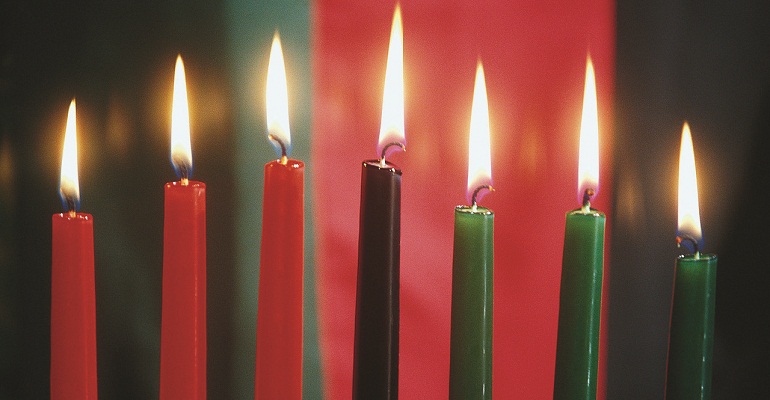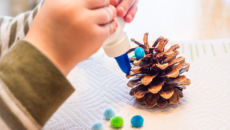Finding Strength in a Shared History
Kwanzaa is a relatively new holiday, but it draws on ancient African traditions. The festival was created in 1966 by Maulana Karenga, Ph.D., an African-American educator, to enrich black culture with African traditions and values. Dr. Karenga built Kwanzaa around seven principles: the unity of family and community; self-determination; working collectively to achieve success; supporting black-owned businesses; acting with purpose to improve the future; using creativity to bring beauty to the world; and believing in the struggle to build a better life for African Americans.
The festival begins December 26 and lasts seven days. Each day the family gathers to light candles, discuss the meaning of that day’s Kwanzaa principle, and drink from the “unity cup.” Kwanzaa is now celebrated in millions of American homes and in many community gatherings. To bring Kwanzaa into your home:
- Prepare a table with the seven symbols of Kwanzaa. Cover a table with a black or green cloth, topped by a straw or handmade mkeka (mat). On the mat, place fruits and vegetable to celebrate the African harvest; a unity cup, from which everyone will drink to show community; a kinara, a candle holder that symbolizes African-American ancestors; seven candles, which represent the principles of Kwanzaa; an ear of dried corn for each child; and gifts.
- Light the kinara candles. The kinara is set up with three red candles on the left, three green candles on the right, and a black one in the center. On the first night of Kwanzaa, light the black candle. The second night, light the black one, plus the farthest red candle. The third night, add the farthest green one. Continue the pattern each night, alternating colors, until all candles are glowing.
- Choose gifts in the spirit of the holiday. It’s customary to give children books or educational toys, heritage symbols, handmade items, or family keepsakes. Gifts are usually given on the sixth day.
- On the sixth day, hold a feast. Gather friends and family to celebrate the holiday. Invite them to share their creativity—the principle of the day—by performing plays, reading poems, and telling stories.
- Shout “Harambee!” (“Let’s all pull together”) seven times, in honor of the seven beliefs of Kwanzaa.
Recipe: Hoppin’ John for New Year’s Day
Some storytellers say that Hoppin’ John was a servant who had to hop around the table to keep up with requests for seconds of his delicious black-eyed-peas-and-rice dish. Others claim that children did the hopping, excited at the meal they were about to eat. More certain is the fact that African slaves introduced the dish to South Carolina, probably by way of the West Indies. An enduring favorite of the American South, many families have made it a Kwanzaa, as well as a good-luck New Year’s Day, tradition.
Ingredients:
- 1 cup dried black-eyed peas
- 1 medium onion, finely chopped
- 1 small smoked ham hock, cut into chunks by the butcher
- 1 small dried hot red chili, or pinch cayenne pepper
- 1 teaspoon salt
- Freshly ground black pepper
- 1/4 – 1/2 teaspoon dried thyme (optional)
- 1 cup uncooked rice (traditional recipes call for long-grain rice; try aromatic Texmati or basmati rice)
- Hot pepper sauce, to taste
Directions:
- In a large saucepan, combine the peas with 6 cups water. Add the onion, ham hock, chili, salt, pepper to taste, and thyme, if using. Bring to a boil, then simmer until the peas are soft, not mushy, about 1 1/2 hours.
- Drain the cooking liquid from the peas in a measuring cup. Save 2 cups of the liquid to cook the rice. If necessary, add hot water to equal 2 cups.
- Pour the 2 cups of liquid back into the peas. Add the rice, stir, then cover and cook over low heat, 20 minutes. Without lifting the lid, set the pot aside to steam for 15 minutes. Fluff the mixture and serve immediately with the hot pepper sauce.
Serves 4 as a main dish, 6 as a side dish. Delicious with collard, turnip, or mustard greens and cornbread.



